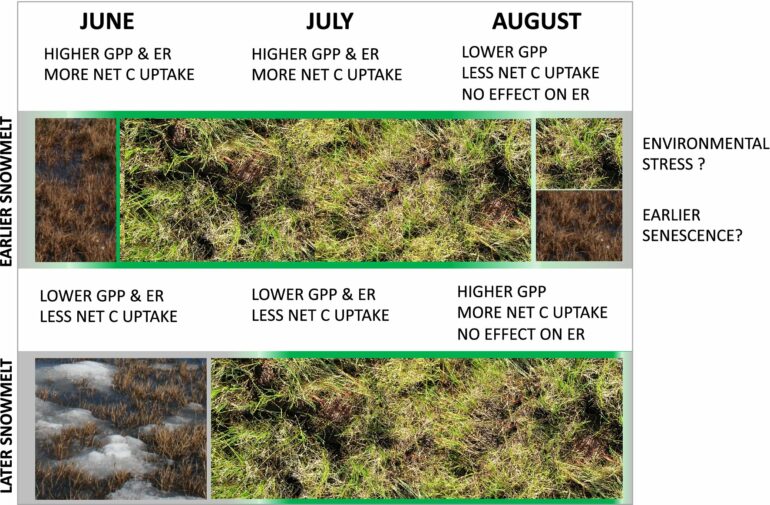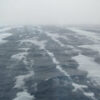Every year, when the long, dark Arctic winter begins its retreat, the tundra ecosystem comes to life.
“It goes from this kind of stark, dark, icy desert, and then all of a sudden it greens up and you hear nothing but songbirds everywhere and you see these snowy owls and sometimes caribou. It’s wonderful,” said ecology graduate student Josh Hashemi, who has witnessed the transformation while doing fieldwork in northern Alaska.
Because of climate change, however, the snowmelt now occurs earlier each year. This results in a longer growing season for tough tundra plants like shrubs and sedges: the so-called “greening” of the Arctic.
A new study led by Hashemi’s advisor, San Diego State University biologist Donatella Zona, found that the shift could compromise the tundra’s ability to store carbon, keeping it out of the atmosphere. Zona, Hashemi and an international team of scientists working in Alaska, Canada, Greenland and Siberia have studied the consequences of the early snowmelt for the past five years.
“Models and large-scale remote sensing have been showing this greening of the Arctic. But you don’t know if it really translates to more carbon sequestration from tundra ecosystems,” said Zona. “Most large-scale studies use some field-level data, but not to the extent we use here. This is a fully data-driven study across the northernmost understudied tundra ecosystems across the Arctic.”.
The work to obtain these data can be grueling. Hashemi, who is part of a joint doctoral program between SDSU and the University of California, Davis, served as a technician at the Alaskan field sites from 2017–21, but also doubled as a biologist, electrician and handyman. In remote Ivotuk, Alaska, he slept in a tent surrounded by an electrified bear fence.
“It can be very challenging. In general, anything that would take ‘x’ amount of time anywhere else will take five times longer in the Arctic,” he said.
His work involves climbing small towers in the tundra to monitor instruments that quantify CO2 exchange at the interface of soil, vegetation and air.
“We measure carbon flux. That is the amount of atmospheric carbon that goes into the system versus going out. How much CO2 the tundra’s producing, and at what rates it’s being emitted from the surface,” said Hashemi.
The Arctic tundra has long been considered a carbon sink. That’s a good thing: the amount of carbon stored by photosynthesizing plants during the summer exceeds the amount that’s lost to the atmosphere.
The plants eventually decompose into the soil, and the long winters keep the soil from releasing carbon dioxide, counteracting climate change. Zona says it’s important for people to appreciate just how big a role the tundra ecosystem has the potential to play in the global carbon balance.
“The total amount of carbon in the permafrost soil is roughly double the amount in the atmosphere. It’s stored there because it’s cold there, because the growing season is just a short amount of time. The rest of the time, everything is mostly frozen,” Zona said.
The scientific community disagrees about whether the earlier snowmelt leads to an increase in overall CO2 storage due to a longer growing season. Answering that question will help determine whether the Arctic will remain a carbon sink.
The study, published in the journal Scientific Reports, found that while plant growth and carbon storage increase at the beginning of the growing season in June, and in the peak of the season in July, both start to wane near the end of it, in August. They are still trying to work out why this is happening, but one possibility is that the early snowmelt causes the plants to age and die back sooner.
“We show that the earlier snowmelt stimulates the carbon uptake and the plant productivity in earlier and midsummer periods, but actually decreases in the late season. It’s a little bit like you wake up earlier, then in the evening, you are tired earlier,” Zona said.
That means the decline in photosynthesis and net carbon storage in August due to the earlier snowmelt may be hindering overall CO2 uptake during the entire summer. This could disrupt the carbon balance in the Arctic and jeopardize tundra’s role as a carbon sink.
“If the plants cannot store more carbon because of something that is limiting the duration of the carbon storage, then we have something that is not decreasing climate change but something that is increasing climate change,” Zona said. “If our ecosystems are responding in an unexpected way by increasing carbon loss, it’s a big deal, because even the things we assume are helping us out are not. If we do not start reducing carbon emitted into the atmosphere, we’re going to bake.”
More information:
Donatella Zona et al, Earlier snowmelt may lead to late season declines in plant productivity and carbon sequestration in Arctic tundra ecosystems, Scientific Reports (2022). DOI: 10.1038/s41598-022-07561-1
Provided by
San Diego State University
Citation:
New study says an earlier spring could jeopardize the Arctic tundra’s ability to store carbon (2022, March 22)



